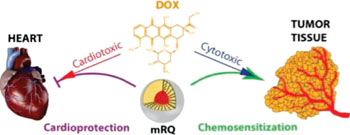Micelles Containing Resveratrol and Quercetin Reverse Doxorubicin Cardiotoxicity
By LabMedica International staff writers
Posted on 29 Jul 2015
Cancer researchers blocked the toxic effects of the cancer drug doxorubicin (DOX) by administering it together with the plant antioxidants resveratrol and quercetin.Posted on 29 Jul 2015
Although in use for more than 40 years as a primary chemotherapy drug, DOX is known to cause serious heart problems. To prevent these, doctors may limit the amount of DOX given to each patient so that the total amount a patient receives over her or his entire lifetime is 550 milligrams per square meter, or less. Furthermore, the necessity to stop treatment to protect the patient from heart disease may diminish the usefulness of DOX in treating cancer. The postulated mechanism of the cardiotoxicity is generation of reactive oxygen and nitrogen species.

Image: A new micelle delivery system for the protective polyphenols resveratrol and quercetin (mRQ) may have value in cancer chemotherapy (Photo courtesy of Oregon State University).
Natural products like resveratrol and quercetin are known as free radical scavengers and have shown cardioprotective effects. However, concurrent dosing of these natural products with DOX is limited due to their low solubility and low oral bioavailability.
Quercetin is a naturally occurring plant bioflavonoid. Foods rich in quercetin include black and green tea, capers, apples, onion, especially red onion, red grapes, citrus fruit, tomato, broccoli and other leafy green vegetables, and a number of berries including cherry, raspberry, bog whortleberry, lingonberry, cranberry, chokeberry, sweet rowan, rowanberry, sea buckthorn berry, crowberry, and the fruit of the prickly pear cactus.
Resveratrol (trans-3,5,4'-trihydroxystilbene), a compound found largely in the skins of red grapes, is a component of Ko-jo-kon, a form of oriental medicine used to treat diseases of the blood vessels, heart, and liver. Red wine contains between 0.2 and 5.8 milligrams per liter of resveratrol, depending on the grape variety, while white wine has much less—the reason being that red wine is fermented with the skins, allowing the wine to absorb the resveratrol, whereas white wine is fermented after the skin has been removed. Resveratrol came to scientific attention during the mid-1990s as a possible explanation for the "French Paradox"—the low incidence of heart disease among the French, who eat a relatively high-fat diet. Since then, it has been promoted by manufacturers and examined by scientific researchers as an antioxidant, an anticancer agent, and a phytoestrogen.
Investigators at Oregon State University (Portland, USA; www.orst.edu) sought to abolish the cardiotoxicity of DOX by administering it together with Life Technologies (Carlsbad, CA, USA) Pluronic F127micelles containing a mixture of resveratrol (1.1 milligram per milliliter) and quercetin (1.42 milligram per milliliter). Pluronic F-127 is a nonionic, surfactant polyol (molecular weight approximately 12,500 daltons) that has been found to facilitate the solubilization of water-insoluble dyes and other materials in physiological media.
Results published in the July 6, 2015, online edition of the Journal of Controlled Release revealed that the in vitro release of resveratrol and quercetin from the micelles followed first order kinetics over 48 hours. In vitro cell viability and combination index analysis studies in human ovarian cancer cells (SKOV-3) and rat cardiomyocytes (H9C2) showed that mixing the antioxidants and DOX at 10:10:1 ratio had a toxic effect on the SKOV-3 cancer cells and a protective effect on the H9C2 heart cells. Healthy mice were exposed to acute doses of DOX and DOX mixed with the antioxidant micelles. Based on biochemical estimations this mixture conferred full cardioprotection in these mice.
"This has great potential to improve chemotherapeutic cancer treatment," said senior author Dr. Adam Alani, assistant professor of pharmacy at Oregon State University. "The co-administration of high levels of resveratrol and quercetin, in both in vitro and in vivo studies, shows that it significantly reduces the cardiac toxicity of DOX, and these compounds have a synergistic effect that enhances the efficacy of the cancer drug, by sensitizing the cancer cells to the effects of the drug."
"There are several advantages with this system," said Dr. Alani. "We can finally reach clinical levels of these polyphenols in the body. We can load both the compounds at one time to help control the cardiotoxicity of the cancer drug, and we can help the polyphenols accumulate in cancer cells where they have their own anticancer properties. This is like hitting three birds with one stone. It has great potential."
Related Links:
Oregon State University
Life Technologies










 (3) (1).png)



